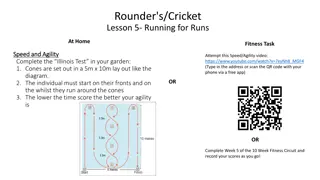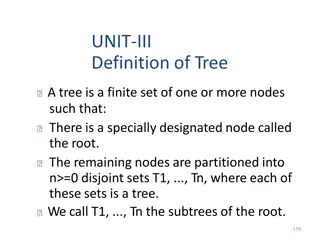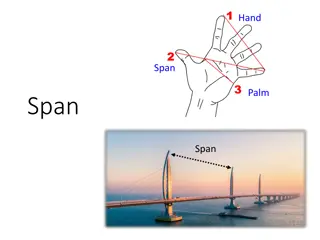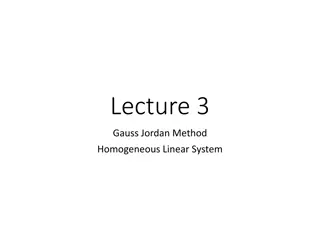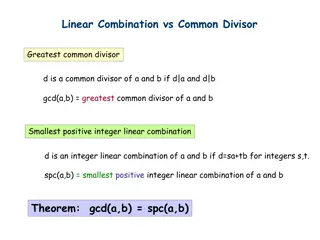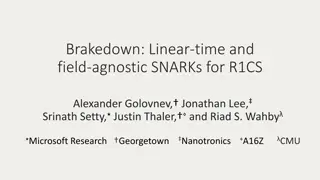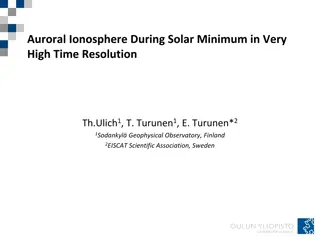Linear Function Modeling in Snowy Tree Cricket Chirp Rates
Based on the book "Functions, Data, and Models" by S.P. Gordon and F.S. Gordon, this presentation discusses how to model the chirp rate of snowy tree crickets in relation to temperature using linear functions. It covers finding the linear function, interpreting the slope and intercept, determining domain and range, making predictions, and practical implications. Through examples and solutions, the concept of linear function modeling is explained with a focus on chirp rates and temperatures.
Download Presentation

Please find below an Image/Link to download the presentation.
The content on the website is provided AS IS for your information and personal use only. It may not be sold, licensed, or shared on other websites without obtaining consent from the author. Download presentation by click this link. If you encounter any issues during the download, it is possible that the publisher has removed the file from their server.
E N D
Presentation Transcript
Modeling with Linear Functions All slides in this presentations are based on the book Functions, Data and Models, S.P. Gordon and F. S Gordon ISBN 978-0-88385-767-0
Example 1 Example 1 The following data relate the snowy tree cricket s chirp rate, R, in chirps per minute, to the temperature, T, in Fahrenheit. Temperature T ( F) Rate, R (chirps/minutes) 50 40 55 60 60 80 65 100 70 120 75 140 80 160 a. Find a linear function that models the chirp-rate as a function of temperature. b. Discuss the practical meaning of the slope and the vertical intercept and give reasonable values for the domain and range. c. Use the linear function in part (a) to predict the chirp rate when the temperature is 84 . d. Use the function to predict the temperature if a snowy cricket is chirping 132 times per minute. p. 2
Example 1 Solution to Part a Example 1 The following data relate the snowy tree cricket s chirp rate, R, in chirps per minute, to the temperature, T, in Fahrenheit. a. Find a linear function that models the chirp-rate as a function of temperature. Temperature T ( F) Rate, R (chirps/minutes) 50 40 55 60 60 80 65 100 70 120 75 140 80 160 We can use any two of the given points-say, (55, 60) and (75, 140)- to find the equation of this linear function. As shown in figure 3.15, the rise is from R = 60 to R = 140, so the rise is 140 60 = 80, and the run is from T = 55 to T = 75, so the run = 20. Therefore, the slope of the line is: ? =???? ???=?2 ?1 ?2 ?1 =140 60 75 55=80 20= 4 Next, we apply the point-slope formula to find the equation of the line, using any point on the line. If we pick (55, 60), we obtain: R 60 = 4(T 55) R 60 = 4T 220 (Distributive Rule) Adding 60 to both sides of the equation, we get: R = f(T) = 4T - 160 p. 3
Example 1 Solution to Part b, c Example 1 The following data relate the snowy tree cricket s chirp rate, R, in chirps per minute, to the temperature, T, in Fahrenheit. Temperature T ( F) Rate, R (chirps/minutes) 50 40 55 60 60 80 65 100 70 120 75 140 80 160 b. Discuss the practical meaning of the slope and the vertical intercept and give reasonable values for the domain and range. b. The slope m = 4 tells us that the cricket s chirp rate goes up 4 chirps/minute for every 1 F increase in temperature. Since R = f(T) = 4T 160, the equation tells us that the vertical intercept is R = -160 (when T = 0). Of course, a chirp rate of R = -160 chirps per minute is meaningless. Domain: 40 ? 80 and Range: 0 ? 160 c. Use the linear function in part (a) to predict the chirp rate when the temperature is 84 . c. If the temperature T = 84 F, the linear function predicts that the snowy tree crickets chirp at a rate of: R = f(84) = 4*84 160 = 336 160 = 176 chirps/minute. p. 4
Example 1 Solution to Part d Example 1 The following data relate the snowy tree cricket s chirp rate, R, in chirps per minute, to the temperature, T, in Fahrenheit. Temperature T ( F) Rate, R (chirps/minutes) 50 40 55 60 60 80 65 100 70 120 75 140 80 160 d. Use the function to predict the temperature if a snowy cricket is chirping 138 times per minute. d. R = 4T 160, since R = 132, we substitute it into the equation. 132 = 4T 160 (now add 160 to both sides) 292 = 4T (now divide both sides by 4) 73 F p. 5
Example 2 Example 2 In 1980, the annual average number of cigarettes smoked by people in the United States was 2930. By 2000, the annual average number of cigarettes consumed in the United States dropped to 1550. a. Assuming the trend in the average number of cigarettes consumed in the United States is linear, find the equation of the linear function. b. Assuming the trend continues, predict the average number of cigarettes consumed by the people in the United States in 2012. p. 6
Example 2 Solution part (a) Example 2 In 1980, the annual average number of cigarettes smoked by people in the United States was 2930. By 2000, the annual average number of cigarettes consumed in the United States dropped to 155. a. Assuming the trend in the average number of cigarettes consumed in the United States is linear, find the equation of the linear function. p. 7
Example 2 Example 2 In 1980, the annual average number of cigarettes smoked by people in the United States was 2930. By 2000, the annual average number of cigarettes consumed in the United States dropped to 1550. b. Assuming the trend continues, predict the average number of cigarettes consumed by the people in the United States in 2012. ? = 69? + 139,550 If t = 2012, we substitute into the function. ?? ??? ? = 69 2012 + 139,550 = 138,828 + 139,550 = 722 p. 9
Example 3 Example 3 In 2008, the net income of the ABC company was $520 million and has been increasing by $40 million per year since. Over the same period, its chief rival XYZ corporation has been growing at a rate of $25 million per year starting with $600 million in 2008. a. Which company earned more income in 2018? b. When did/will ABC surpass XYZ? p. 10
Example 3 Solution part (a) Example 3 In 2008, the net income of the ABC company was $520 million and has been increasing by $40 million per year since. Over the same period, its chief rival XYZ corporation has been growing at a rate of $25 million per year starting with $600 million in 2008. a. Which company earned more income in 2018? Let t = 0 in 2008, then these are the net income functions for the two companies ????= 40? + 520 ????= 25? + 600 The year 2018 corresponds to t = 10, so we plug 10 into both functions ????= 40 10 + 520 = 920 ????= 25 10 + 600 = 850 So company ABC had a larger net income in the year 2018 p. 11
Example 3 Solution part (b) Example 3 In 2008, the net income of the ABC company was $520 million and has been increasing by $40 million per year since. Over the same period, its chief rival XYZ corporation has been growing at a rate of $25 million per year starting with $600 million in 2008. b. When did/will ABC surpass XYZ? Hit the 2nd Trace keys, then hit 5 (intersect) to solve. Hit enter 3 times to see the solution. Type the two equations in your TI 83/84 Plus Use the blue WINDOW key to set the scaling p. 12
Example 3 Solution part (b) Type the two equations in your TI 83/84 Plus Hit the 2nd Trace keys, then hit 5 (intersect) to solve. Hit enter 3 times to see the solution. Use the blue WINDOW key to set the scaling p. 13

























